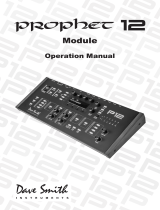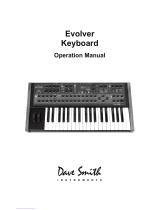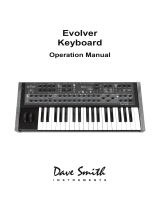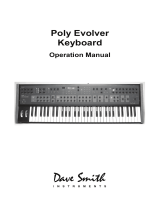Page is loading ...

Operation Manual


i
Prophet 12 Operation Manual
Operation Manual
Version 1.0
May 2013
Dave Smith Instruments
1527 Stockton Street, 2nd Floor
San Francisco, CA 94133
USA
©2013 Dave Smith Instruments
www.davesmithinstruments.com

ii
Dave Smith Instruments
This device complies with Part 15 of the FCC Rules. Operation is subject to
the following two conditions: (1) This device may not cause harmful inter-
ference and (2) this device must accept any interference received, including
interference that may cause undesired operation.
This Class B digital apparatus meets all requirements of the Canadian
Interference-Causing Equipment Regulations.
Cet appareil numerique de la classe B respecte toutes les exigences du
Reglement sur le materiel brouilleur du Canada.
For Technical Support, email: [email protected]

iii
Prophet 12 Operation Manual
Table of Contents
Thank You ..........................................vii
Overview. . . . . . . . . . . . . . . . . . . . . . . . . . . . . . . . . . . . . . . . . . . . .1
Getting Started ..........................................1
Using the Display and “Soft” Controls .........................2
Using Show and Revert Param .............................3
Saving Programs ........................................3
Moving to the Next Level ..................................4
Connections ..........................................6
Global Settings .......................................8
Oscillators ..........................................12
Character ...........................................17
Low-Pass Filter ......................................18
High-Pass Filter ......................................21
Voltage Controlled Amplier ...........................22
Feedback ...........................................24
Delay ...............................................25
Reverb and Modulation-Based Effects .......................26
Low Frequency Oscillators. . . . . . . . . . . . . . . . . . . . . . . . . . . . .28
Auxiliary Envelopes ..................................31
Modulation ..........................................32
Using the Assign Mod Buttons .............................32

iv
Dave Smith Instruments
Distortion ...........................................34
Unison .............................................35
Glide ...............................................36
Hold ................................................37
Arpeggiator .........................................38
Master Volume/Voice Volume ...........................40
Pitch and Modulation Wheels ...........................41
Touch Sliders ........................................42
Layers, Split, and Stack ...............................43
Managing Layers .......................................43
Play List ............................................45
Using USB ..........................................47
Appendix A:
Modulation Sources ..................................49
Appendix B:
Modulation Destinations ...............................50
Appendix C:
Delay Times .........................................52
Appendix D:
MIDI Implementation ..................................57
MIDI Messages ......................................... 58
NRPN Messages .......................................64
Sysex Messages ........................................85
Packed Data Format ..................................... 88

v
Prophet 12 Operation Manual
Credits and Acknowledgements
For Sound Design:
Matia Simovich
James Terris
Mitch Thomas
Mark Wilcox
Taiho Yamada
Alessandro Cortini
Richard Devine
Rory Dow
Peter Dyer
Tim Koon
Kurt Kurasaki
Jamie Lidell
Tim Mantle (Psalm37)
Phil Peskett
Lorenz Rhode
Special thanks also to: Ken Eddleman, Jeff Pence, Robert Rich, and Riley Smith
And to the DSI crew: Bob Coover, Carson Day, Chris Hector, Tony Karavidas,
Mark Kono, Andrew McGowan, Joanne McGowan, and Tracy Wadley

vi
Dave Smith Instruments

vii
Prophet 12 Operation Manual
Thank You
Thank You
I’ve been designing synthesizers for 35 years now, starting with the Prophet-5
in 1978. Often times over the years, people have asked which instrument is
my favorite. I’ve never been able to answer that question; it’s like picking
your favorite child. The Prophet-5 since it was the rst, and a breakthrough
instrument? The Evolvers with their hybrid analog/digital architecture? The
Prophet ’08, as a modern analog poly synth, a full-featured followup 30 years
after the Prophet-5? The Prophet VS? Wavestation?
The problem is now resolved: the Prophet 12 is my favorite. No question. It
sounds different than my other designs, yet it retains the Prophet vibe. There’s
something magical about the combination of a digital front end followed with
analog lters and electronics per voice. The Prophet 12 has a sound, a soul of its
own, unlike any other instrument. I love it!
I hope you enjoy playing this instrument as much as we enjoyed designing it.
Thanks for the purchase, from the team at DSI!
Cheers,

viii
Thank You
Dave Smith Instruments

1
Prophet 12 Operation Manual
Overview
Overview
This is a brief overview of the Prophet 12’s capabilities and its operation.
More in-depth information about specic parameters can be found in the
reference section of the manual. However, don’t let a lack of familiarity
with either the instrument or synthesis prevent you from turning knobs
and pressing buttons. That’s what they’re there for! You won’t break
anything and you can always get back to where you started, even if you
have no idea what you’re doing. Great things can occur with synthesizers
when you don’t quite know what to expect, so start twiddling and keep
your ears—and mind—open.
Getting Started
The Prophet 12 is a twelve-voice, polyphonic synthesizer. That means
up to twelve distinct notes can play simultaneously. The Prophet 12 is a
hybrid synthesizer. That is, it uses a combination of digital and analog
audio electronics to generate its sounds, called programs.
The Prophet 12 contains 792 programs organized into eight banks of 99.
Half the programs are in four Factory banks and the rest are in four User
banks. When a Prophet 12 leaves the factory, the User banks are an exact
copy of the Factory banks. Program 1 in bank 1 of the User banks is the
same as program 1 in bank 1 of the Factory banks, User program 2 is the
same as Factory program 2, and so on. All programs in either the Factory
or User banks can be edited using the front panel controls, but the edits
cannot be saved to the Factory banks, only the User banks. The Factory
banks are read only, permanent.
Choosing programs is simple. Choose User Banks or Factory Banks,
use Bank select to choose bank 1, 2, 3, or 4, and then use the numeric
keypad to enter the program number, 01 through 99. Or use Pgm UP and
Pgm Down to step though consecutive programs.
While auditioning programs, it should become obvious that some
programs are split—two different sounds can be played from different
zones of the keyboard—and some are stacked—one sound is layered on
another. The Prophet 12 is bi-timbral. That is, it can play two different
sounds simultaneously and each of those sounds can be routed to its own
stereo outputs, if desired. Each of the Prophet 12’s program memory
locations is capable of saving and recalling two different programmed

2
Overview
Dave Smith Instruments
sounds, one in layer A and one in layer B. Layers are used to facilitate
split and stacked programs.
A split program maps the layer A sound to a key zone on the left side of
the split point and the layer B sound to the right. Six voices are allocated
to each key zone.
A stacked program maps both layers A and B to the entire keyboard, with
six voices allocated to each layer. So, when stack a + B is on, the maxi-
mum polyphony is six. (At least two voices play with each keystroke.)
The voice activity LEDs indicate how the voices are being used.
If sPlit a | B or stack a + B are not on, the layer B sound can still be
accessed and edited by pressing eDit layer B. This also provides a
shortcut to switch quickly between two sounds without actually changing
programs.
Using the Display and “Soft” Controls
The Prophet 12’s more performance-oriented parameters are all acces-
sible via dedicated knobs and switches on the front panel, but there are
even more parameters available via the OLED display. For example,
there are fteen knobs and switches in the Oscillator section. Editing
any of those controls reveals those parameters and their exact values—
as well as four additional oscillator parameters—in the display. Those
parameters are selected and tweaked using the four soft knobs and soft
keys located above and below the display. The soft knobs are detented
encoders and are great for dialing in specic values.
The “Soft Knobs”
The “Soft Keys”

3
Prophet 12 Operation Manual
Overview
Using Show and Revert Param
Editing a program’s parameters causes the value for that parameter to be
displayed. But what if you want to see the value without editing it? show
allows a parameter to be displayed without actually changing it. Simply
press and hold show, and turn a knob or press a switch to display the
current setting. Or press show to turn it on and review multiple param-
eter settings before turning show off again.
Tip: Hold show and move the pitch wheel to see the bend range
settings.
At any point while editing a program, turn on comPare to hear the saved,
unedited program. Or, to revert to the saved program, just reload it by
pressing the lit Bank select switch. You can also revert a single param-
eter using revert Param. Just press and hold revert Param and turn a
knob to restore it to its saved value.
Saving Programs
Saving an edited program is easy. As mentioned previously, you can
compare the edited program to the saved program at any time using
comPare. Once you’re ready to commit, press write.
A. Write Bank (soft knob 1)—Choose the User Bank (1 through 4) to
which the program will be saved.
B. Write Program (soft knob 2)—Choose the program (1 through 99) to
which the program will be saved.
C. Select Char (soft knob 3)—Highlight a character in the current layer’s
name.

4
Overview
Dave Smith Instruments
D. Edit Char (soft knob 4)—Choose a character.
E. Copy Name A > B (soft key 1)—Copy the layer A name to layer B.
F. Insert Char (soft key 2)—Insert a character before the selected character.
G. Delete Char (soft key 3)—Delete the selected character.
H. Layer A/B (soft key 4)—Switch between the layer A and layer B name.
Saving a program overwrites a previously saved program. While write
is blinking, comPare lets you “audition” the saved program in the bank
and program location you have selected.
Moving to the Next Level
This overview just covers basic operation. The Prophet 12 is a deep
instrument lled with possibility and playing it is a lot more compelling
than reading a manual. But we would like to point you in the direction
of a few things that will help you tailor the instrument to your needs.
In particular, check out the Global Settings section of the manual. Read
about Pot Modes and determine which works best for you. You’ll also
nd information about MIDI setup to more effectively integrate the
Prophet 12 into your rig, as well as information about using a footswitch
and expression pedals. Also, look for the tips and notes scattered
throughout the manual to gain a better working knowledge of the
instrument.

5
Prophet 12 Operation Manual
OSC 1
SUB OSC LEVEL
FEEDBACK LEVEL
CHARACTER
FEEDBACK LOOP
VCA
PAN
L
R
SUB OSC
OSC 2
OSC 3
OSC 3 LEVEL
OSC 4 LEVEL
OSC 4
OSC 1 LEVEL
OSC 2 LEVEL
LPF
DECI AIR GIRTH DRIVE HACK
HPF
PROPHET 12 VOICE ARCHITECTURE
Modulation routing omitted for clarity
OSC
MIX
FDBK TUNE
PAN
L
R
PAN
L
R
PAN
L
R
PAN
L
R
DELAY
1
DELAY
2
DELAY
3
DELAY
4

6
Connections
Dave Smith Instruments
USB
Sustain
100-24 0 VAC
50-6 0 Hz
30 Wat ts
Pedal 1 Pedal 2 Right Left Right
Left
Headphones
MIDI In
MIDI Out MIDI Thru
B Outputs Main / A Outputs
USB
Sustain
100-240 VAC
50-60 Hz
30 Watts
Pedal 1 Pedal 2
Right Left Right
Left
Headphones
MIDI In
MIDI Out MIDI Thru
B Outputs Main / A Outputs
Connections
AC Power Inlet—Accepts a standard, grounded IEC power cord. Oper-
ates over a range of 100 to 240 volts and 50 to 60 Hz.
USB—For bidirectional MIDI communication with a computer. The
Prophet 12 is a Class Compliant USB device and does not require addi-
tional drivers when used with Mac OS or Windows. See Using USB on
page 47 for more information.
Sustain—Accepts a momentary, normally open or normally closed
footswitch to control sustain or to turn the arpeggiator on and off. See
“Sustain Footswitch” under Global Settings on page 10 for more
information.
Pedal 1 and Pedal 2—Accept a standard expression pedal that has a
variable resistor on a TRS (tip-ring-sleeve) ¼″ phone plug. For more
information, see “Pedal 1 Function” and “Pedal 2 Function” in Global
Settings on page 10.

7
Prophet 12 Operation Manual
Connections
USB
Sustain
100-24 0 VAC
50-6 0 Hz
30 Wat ts
Pedal 1 Pedal 2 Right Left Right
Left
Headphones
MIDI In
MIDI Out MIDI Thru
B Outputs Main / A Outputs
USB
Sustain
100-240 VAC
50-60 Hz
30 Watts
Pedal 1 Pedal 2
Right Left Right
Left
Headphones
MIDI In
MIDI Out MIDI Thru
B Outputs Main / A Outputs
MIDI In, Out, and Thru—Standard 5-pin MIDI DIN connectors.
Main/A Outputs and B Outputs—Unbalanced, ¼″ audio outputs. The
Main outputs are a mix of a program’s A and B layers. When plugs
are inserted into the B outputs, only layer A is available from the Main
outputs and layer B is routed to the B outputs. See Layers, Split, and
Stack on page 43 for more information. The Prophet 12 sounds great
in stereo, but can be switched to mono. See “Mono/Stereo” in Global
Settings on page 9.
Headphones—A ¼″ stereo headphone jack.

8
Global Settings
Dave Smith Instruments
Global Settings
Press gloBal to set those parameters, such as Master Tune and MIDI
Channel, which affect all programs globally.
1. Master Coarse Tune: -12…+12—Master Transpose control, 0 is
centered. Steps in semitones as much as one octave up (+12) or down
(-12).
2. Master Fine Tune: -50…+50—Master Fine Tune control; 0 centered.
Steps in cents as much as a quarter-tone up (+50) or down (-50).
3. MIDI Channel: All, 1…16—Selects which MIDI channel to send and
receive data, 1 to 16. All receives on all 16 channels.
4. MIDI Clock Mode: See table—Sets the Prophet 12’s ability to send
and receive MIDI clock messages.
Display MIDI Clock Setting
Off MIDI Clock is neither sent nor received.
Master MIDI Clock is sent, but not received.
Slave MIDI Clock is received, but not sent.
Slave Thru MIDI Clock is received and passed to MIDI Out.
Note: In Slave and Slave Thru modes, if no MIDI clock is present at
the selected input, the arpeggiator will not function.
5. MIDI Clock Cable: MIDI Port, USB—Sets the port, MIDI or USB, by
which MIDI clocks are received.
5. MIDI Param Send: Off, CC NRPN—Changes to the values of front
panel controls are transmitted via MIDI as Non-registered Parameter
Number (NRPN) controllers or as Continuous Controllers (CC). Trans-
mission of parameters can also be turned off. See MIDI Implementation
on page 55 for details.
Note: NRPNs are the preferred method of parameter transmission,
since they cover the complete range of all parameters, while CCs are
limited to a range of 128.

9
Prophet 12 Operation Manual
Global Settings
6. MIDI Param Receive: Off, CC NRPN—Sets the method by which
parameter changes are received via MIDI. As with transmission, NRPNs
are the preferred method.
7. MIDI Control Enable: Off, On—When On, the synth will respond to
MIDI controllers, including Pitch Wheel, Mod Wheel, Pedal, Breath,
Volume, and Expression.
8. MIDI Sysex Enable: Off, On—When On, the synth will respond to
received MIDI SysEx messages, and will transmit them, when prompted,
to the MIDI Out. See Sysex Messages on page 82 for details.
9. MIDI Sysex Cable: None, MIDI Port, USB—Sets the port, MIDI or
USB, by which System Exclusive data will be transmitted and received.
10. MIDI Out Select: Off, MIDI, USB, MIDI+USB—Sets the port by which
MIDI data will be transmitted.
11. Local Control: Off, On—When on (the default), the keyboard and
front panel controls directly affect the Prophet 12. When off, the controls
are transmitted via MIDI but do not directly affect the “local” synth (that
is, the Prophet 12). This is primarily useful for avoiding MIDI data loops
that can occur with some external sequencers.
12. Mono/Stereo: Stereo, Mono—The Prophet 12 defaults to stereo
operation. When set to Mono, this parameter defeats all pan settings and
modulation, effectively making each of the outputs a mono output.
13. Pot Mode: Relative, Passthru, Jump—The rotary controls on the
Prophet 12’s front panel are a mixture of “endless” rotary encoders and
potentiometers or “pots.” The pots are identiable by their lined knobs
and the fact that they have about 300° of travel. There are three pot
modes to determine how the synth reacts when the programmable param-
eters are edited. (Master volume is not programmable, so these modes
don’t apply.)
When set to Relative, changes are relative to the stored setting. In Rela-
tive mode, the full value range is not available until either the minimum
or maximum value and the respective lower or upper limit of the pot’s
travel is reached.

10
Global Settings
Dave Smith Instruments
For example, the Resonance parameter has a value range of 0 to 127.
Let’s say the physical position of the Resonance pot is the equivalent of
a value of 100. If you switch to a program that has a stored Resonance
setting of 63 and turn the pot all the way up, it will only go to 90. To get
to the maximum value of 127, you rst have to turn down until the value
is at the other extreme and the pot is at the limit of its travel (in this case,
0 and fully counter-clockwise, respectively).
In Passthru mode, turning the pot has no effect until after the edited value
equals the preset value (that is, until the edited value “passes through”
the stored value).
Jump mode uses an absolute value based upon the position of the pot
when edited: turn a pot and the value jumps immediately from the stored
value to the edited value.
14. Sustain Footswitch: Normally Open, Normally Closed—There are
two types of momentary footswitches, normally open and normally
closed. Either type can be used with the Prophet 12’s Sustain switch
input. Not sure which type you have? If the footswitch’s behavior is the
opposite of what’s expected—that is, down is off and up is on—changing
this setting will correct that.
16. Sustain Pedal Function: Sustain, Arp On/Off—The footswitch can
be used for sustain or to turn arpeggiator hold on and off.
15. Pedal 1 Function: Breath Control, Foot Controller, Expression,
Master Volume, Lowpass Filter: Full Range, Lowpass Filter: Half
Range—Sets the function/destination for the Pedal 1 input. An expres-
sion pedal can be routed to any destination using the modulation matrix.
See Modulation on page 32 for more information.
16. Pedal 2 Function: Breath Control, Foot Controller, Expression,
Master Volume, Lowpass Filter: Full Range, Lowpass Filter: Half
Range—Sets the function/destination for the Pedal 2 input. . An expres-
sion pedal can be routed to any destination using the modulation matrix.
See Modulation on page 32 for more information.
17. Aftertouch Enable: Off, On—When on, the Prophet 12 will receive
and transmit aftertouch data via MIDI.
/






